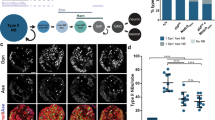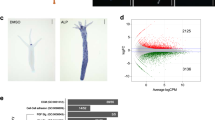Abstract
IN the Drosophila embryo, cell fate along the anterior–posterior axis is determined by maternally expressed genes1,2. The activity of the bicoid {bcd) gene is required for the development of larval head and thoracic structures3, and that of maternal torso (tor)1 for the development of the unsegmented region of the head (acron). In contrast to the case of thoracic and abdominal segmentation4,5, the hierarchy of zygotically expressed genes controlling head development has not been clearly defined. The bcd protein, which is expressed in a gradient6, activates zygotic expression of the gap gene hunchback (hb) 7,8, but hb alone is not sufficient to specify head development. Driever et al.9 proposed that at least one other bcd-activated gene controls the development of head regions anterior to the hb domain. We report here that the homeobox gene orthodenticle (otd), which is involved in head development, could be such a gene. We also show that otd expression responds to the activity of the maternal tor gene at the anterior pole of the embryo.
This is a preview of subscription content, access via your institution
Access options
Subscribe to this journal
Receive 51 print issues and online access
$199.00 per year
only $3.90 per issue
Buy this article
- Purchase on Springer Link
- Instant access to full article PDF
Prices may be subject to local taxes which are calculated during checkout
Similar content being viewed by others
References
Nusslein-Volhard, C., Frohnhofer, H. G. & Lehmann, R. Science 238, 1675–1681 (1987).
Manseau, L. J. & Schupbach, T. Trends Genet. 5, 400–405 (1989).
Frohnhofer, H. G. & Nusslein-Volhard, C. Nature 324, 120–125 (1986).
Akam, M. Development 101, 1–22 (1987).
Ingham, P. W. Nature 335, 25–33 (1988).
Driever, W. & Nusslein-Volhard, C. Cell 54, 83–93 (1988).
Driever, W. & Nusslein-Volhard, C. Nature 337, 138–143 (1989).
Struhl, G., Struhl, K. & Macdonald, P. M. Cell 57, 1259–1273 (1989).
Driever, W., Thoma, G. & Nusslein-Volhard, C. Nature 340, 363–367 (1989).
Wieschaus, E., Nusslein-Volhard, C. & Jurgens, G. Wilhelm Roux Arch. dev. Biol. 193, 286–307 (1984).
Dinardo, S., Kuner, J., Theis, J. & O'Farrell, P. Cell 43, 59–69 (1985).
Baker, N. Development 103, 289–298 (1988).
van den Heuvel, M., Nusse, R., Johnston, P. & Lawrence, P. Cell 59, 739–749 (1989).
Hanes, S. D. & Brent, R. Cell 57, 1275–1283 (1989).
Treisman, J., Gonczy, P., Vashishtha, M., Harris, E. & Desplan, C. Cell 59, 553–562 (1989).
Frigerio, G., Burri, M., Bopp, D., Baumgartner, S. & Noll, M. Cell 47, 735–746 (1986).
Berleth, T. et al. EMBO J. 7, 1749–1756 (1988).
Lehmann, R. & Nusslein-Volhard, C. Devl Biol. 119, 412–417 (1987).
Jurgens, G., Wieschaus, E., Nusslein-Volhard, C. & Kluding, H. Wilhelm Roux Arch. dev. Biol. 193, 283–295 (1984).
Dalton, D., Chadwick, R. & McGinnis, W. Genes Dev. 3, 1940–1956 (1989).
Rosenberg, U. B. et al. Nature 319, 336–339 (1986).
Tautz, D. et al. Nature 327, 383–389 (1987).
Nauber, U. et al. Nature 336, 489–492 (1988).
Jurgens, G., Lehmann, R., Schardin, M. & Nusslein-Volhard, C. Roux Arch. dev. Biol. 195, 359–377 (1986).
van der Meer, J. Dros. Inf. Serv. 52, 160 (1977).
Klingensmith, J., Noll, E. & Perrimon, N. Devl Biol. 134, 130–145 (1988).
Campos-Ortega, J. A. & Hartenstein, V. in The Embryonic Development of Drosophila melanogaster (Springer-Verlag, New York/Berlin. 1985).
Tautz, D. & Pfeifle, C. Chromosoma 98, 81–85 (1989).
Driever, W. & Nusslein-Volhard, C. Cell 54, 95–104 (1988).
Finkelstein, R., Smouse, D., Capaci, T. M., Spradling, A. C. & Perrimon, N. Genes Dev. (in the press).
Author information
Authors and Affiliations
Rights and permissions
About this article
Cite this article
Finklstein, R., Perrimon, N. The orthodenticle gene is regulated by bicoid and torso and specifies Drosophila head development. Nature 346, 485–488 (1990). https://doi.org/10.1038/346485a0
Received:
Accepted:
Issue Date:
DOI: https://doi.org/10.1038/346485a0
This article is cited by
-
A systematic review on the effects of acrylamide and bisphenol A on the development of Drosophila melanogaster
Molecular Biology Reports (2022)
-
Formation and subdivision of the head field in the centipede Strigamia maritima, as revealed by the expression of head gap gene orthologues and hedgehog dynamics
EvoDevo (2017)
-
The study of Priapulus caudatus reveals conserved molecular patterning underlying different gut morphogenesis in the Ecdysozoa
BMC Biology (2015)
-
Components of the dorsal-ventral pathway also contribute to anterior-posterior patterning in honeybee embryos (Apis mellifera)
EvoDevo (2014)
-
Plant-mediated RNAi of a gap gene-enhanced tobacco tolerance against the Myzus persicae
Transgenic Research (2014)
Comments
By submitting a comment you agree to abide by our Terms and Community Guidelines. If you find something abusive or that does not comply with our terms or guidelines please flag it as inappropriate.



